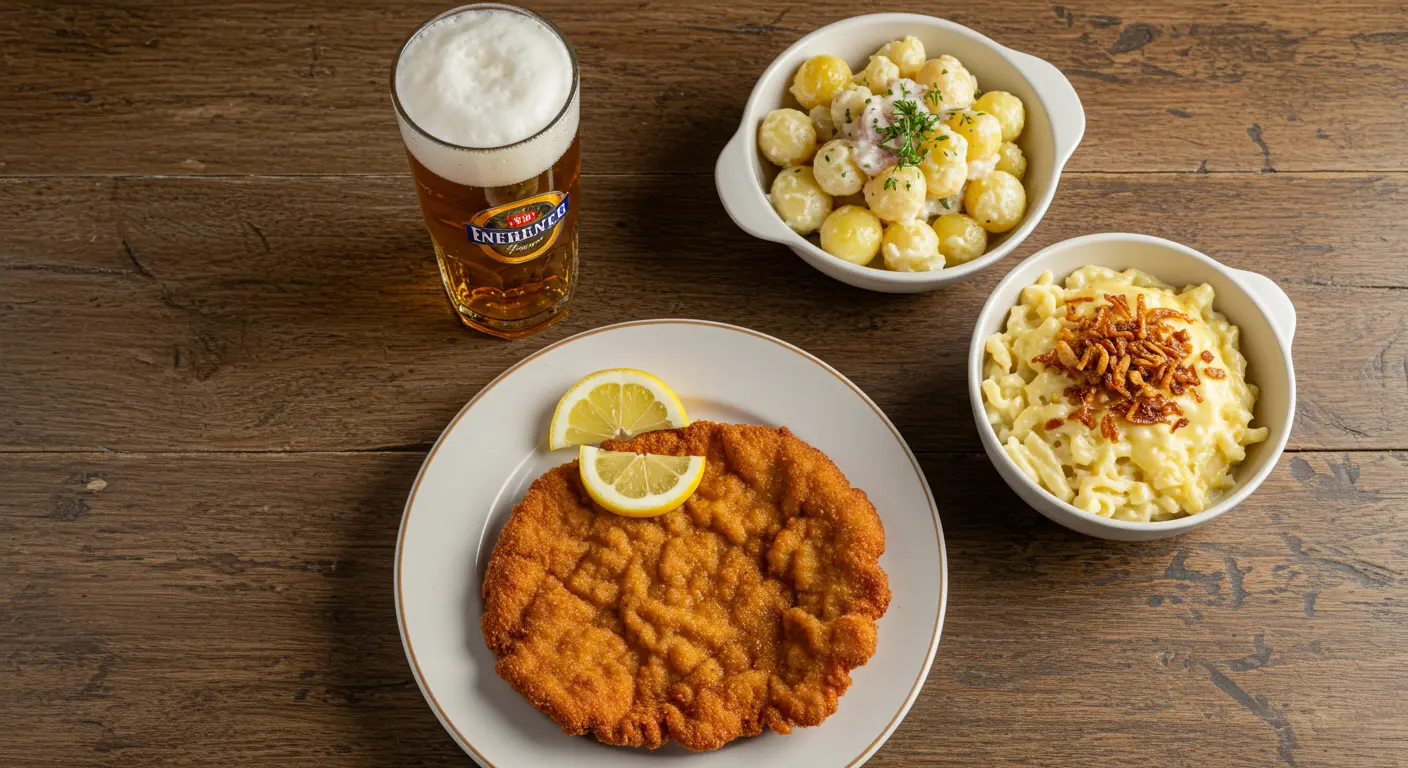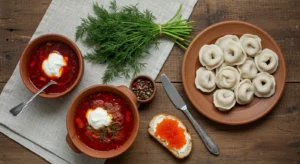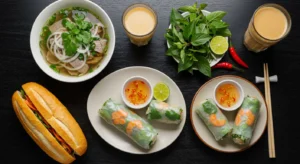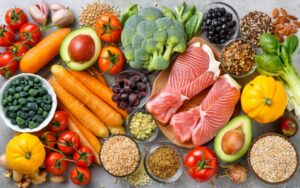Table of Contents
A Beginner’s Guide to the Hearty, Heavenly World of Austrian Food
Picture this: you’re nestled in a wooden booth in a Viennese Gasthaus, the air warm with the scent of roasting coffee and simmering broth. A plate arrives, bearing a golden, crispy cutlet so large it drapes over the edges. It’s not just a meal; it’s a welcome embrace. This is the magic of Austrian food.
If your knowledge of Austrian cuisine starts and ends with Wiener Schnitzel and Apple Strudel, you’re in for a treat. Austrian food is the ultimate comfort cuisine of Central Europe, a hearty and delightful reflection of its history as a grand empire. It’s where rustic Alpine dishes meet the refined elegance of its capital city, Vienna.
This guide is your friendly first step. We’ll demystify the menus, explore the must-try dishes (both famous and hidden gems), and give you the confidence to dive into one of Europe’s most satisfying culinary scenes. Let’s get started.
The Holy Trinity: Austrian Classics You Absolutely Must Know
Every cuisine has its pillars, and Austria’s are wonderfully hearty. Consider these your non-negotiable starting point.
Wiener Schnitzel: The Golden Giant
Let’s get the big one out of the way first. A true Wiener Schnitzel is made exclusively from veal (Kalb). It’s pounded paper-thin, delicately breaded, and fried until it achieves a characteristic “bubbly” and crispy golden crust. It should never sit in grease.
A quick tip from experience: If a menu just says “Schnitzel,” it’s often made from pork (Schwein), which is delicious and more common for everyday meals. But for the authentic article, look for Wiener Schnitzel vom Kalb. It’s traditionally served with a lemon wedge and a simple potato or cucumber salad—no gravy in sight! The joy is in the crispness.
Tafelspitz: The Emperor’s Favorite Boiled Beef
This might sound simple, but Tafelspitz is a dish that reveals the subtle sophistication of Austrian cooking. It’s prime boiled beef, simmered for hours in a broth with root vegetables. The result is meat so tender it practically melts.
The real experience, much like fondue, is in the accompaniments. It’s served with a trio of sauces: creamy chive sauce (Schnittlauchsauce), a sharp apple-horseradish (Apfelkren), and sometimes a spinach sauce. You’ll also get boiled potatoes and roasted minced breadcrumbs. It was reportedly the favorite dish of Emperor Franz Joseph I, which tells you everything you need to know about its status.
Käsespätzle: Austria’s Ultimate Comfort Food
Think of this as the Austrian answer to macaroni and cheese, but with so much more character. Spätzle are soft egg noodles, hand-scraped into boiling water. They’re then layered with vast amounts of melted cheese (usually Emmental or Bergkäse) and topped with crispy fried onions.
It’s the dish you find in Alpine huts after a long hike—cheesy, carb-loaded, and deeply satisfying. Don’t be shy about ordering it as a main course; it’s a meal in itself.
The Sweet Side of Life: Austria’s Legendary Desserts
Austria has a serious sweet tooth, and its desserts (Mehlspeisen) are world-famous for a reason. This is where the influence of the former Austro-Hungarian Empire truly shines.
Apfelstrudel: More Than Just Apples in a Pastry
A good Apfelstrudel is a thing of beauty. The dough should be stretched so thin you could read a newspaper through it, enveloping a filling of tart apples, raisins, cinnamon, and breadcrumbs. It’s always served warm, often with a dusting of powdered sugar and a dollop of vanilla sauce (Vanillesauce). The key is the perfect balance between the delicate, flaky pastry and the sweet, spiced filling.
Sachertorte: Vienna’s Chocolate Icon
No discussion of Austrian food is complete without the Sachertorte. This dense, dry chocolate cake with a layer of apricot jam under a dark chocolate glaze is a symbol of Vienna. It was invented in 1832 at the Hotel Sacher, and the recipe is a closely guarded secret.
Here’s a little insider knowledge: The debate between the Hotel Sacher and the Demel bakery over the “original” recipe was a famous legal battle. Purists argue you must try both! It’s traditionally enjoyed with a generous portion of unsweetened whipped cream (Schlagobers) to cut through the richness.
A Culinary Tour of the Regions
Austria may be small, but its regional specialties are distinct and tied closely to the landscape.
- Vienna (Wien): The melting pot. Here you’ll find the imperial classics like Tafelspitz and the grand cafe culture.
- Salzburg & The Lake District: Known for Salzburger Nockerl, a spectacularly fluffy, sweet soufflé meant to resemble the surrounding mountains.
- Styria (Steiermark): Called the “Green Heart” of Austria, it’s famous for pumpkin seed oil (Kernöl), a dark, nutty oil drizzled over salads and even vanilla ice cream!
- Tyrol (Tirol): Hearty, mountain food reigns supreme. Think Speckknödel (bacon dumplings) served in a clear broth, and Kaiserschmarrn – a shredded pancake with plum compote.
The Ritual of Coffee: More Than a Drink
Ordering a coffee in Austria is not a simple transaction; it’s a ritual. The Viennese coffee house culture is so important that it’s recognized by UNESCO as an Intangible Cultural Heritage. It’s a place to read the paper, meet friends, or simply linger for hours.
Don’t ask for a “black coffee.” Here’s a quick cheat sheet for your order:
- Kleiner Schwarzer: A small black coffee (like an espresso).
- Melange: The most popular order. Similar to a cappuccino, half coffee, half steamed milk.
- Einspänner: A strong black coffee in a glass, topped with a tall dome of whipped cream.
- Wiener Eiskaffee: Iced coffee with vanilla ice cream and whipped cream—a summer delight.
Putting It All Together: Your First Austrian Meal
Feeling overwhelmed? Here’s a perfect, classic meal order for a beginner:
- Starter: A clear beef broth with a pancake strip (Frittatensuppe) or a hearty Grießknödel (semolina dumpling) soup.
- Main Course: A Wiener Schnitzel vom Schwein (pork) with a side of potato salad. Or, if you’re feeling adventurous, Tafelspitz.
- Dessert: A warm slice of Apfelstrudel with vanilla sauce.
- Drink: A cold, Austrian beer (Stiegl or Gösser are great brands) or an Almdudler (a popular herbal lemonade).
And remember, always leave room for the Schlagobers.
FAQs: Your Austrian Food Questions, Answered
Q: Is Austrian food just like German food?
A: While they share similarities, Austrian cuisine is generally considered more refined and influenced by its former empire (Hungarian, Czech, Italian). It places a greater emphasis on desserts, pastries, and coffeehouse culture.
Q: What is a typical breakfast in Austria?
A: It’s often a simple affair. You’ll find a selection of bread rolls (Semmeln), cold cuts (Aufschnitt), cheese (Käse), jam (Marmelade), and a soft-boiled egg. Of course, coffee is essential.
Q: I’m a vegetarian. Will I find options?
A: Absolutely! While meat-heavy, Austria has wonderful vegetarian dishes. Käsespätzle (cheese noodles), Salatbuffet (salad bars), Erdäpfelgulasch (potato goulash), and various mushroom dishes are widely available. Just ask.
Q: What should I drink with my meal besides coffee?
A: Austrian wines are world-class but often overlooked. Try a crisp Grüner Veltliner (white) or a bold Blaufränkisch (red). For non-alcoholic options, Almdudler is the national soft drink, and tap water (Leitungswasser) is safe to drink, though it’s polite to order a mineral water (Mineralwasser) in a restaurant.
Q: What’s the deal with the pumpkin seed oil?
A: Styrian pumpkin seed oil is a unique, dark green oil with a wonderfully nutty flavor. Austrians are passionate about it. Drizzle it over a simple green salad, or for a real local treat, try it drizzled over vanilla ice cream! It sounds strange, but it’s delicious.
Ready for Your Own Taste of Austria?
Austrian food is a journey of discovery. It’s the satisfying crunch of a perfect Schnitzel, the comforting warmth of a cheesy Käsespätzle, and the simple pleasure of lingering over a Melange in a grand cafe. It’s a cuisine built on tradition, quality ingredients, and a genuine love for good living.
So, the next time you see an Austrian restaurant or find yourself planning a trip, you’ll be ready. You’re no longer a beginner—you’re an explorer with a map to some of the most comforting and delicious food Europe has to offer. Guten Appetit!
To dive deeper into the history and recipes of these classic dishes, a fantastic resource is the official website of the Austrian National Tourist Office, which offers detailed cultural insights.




